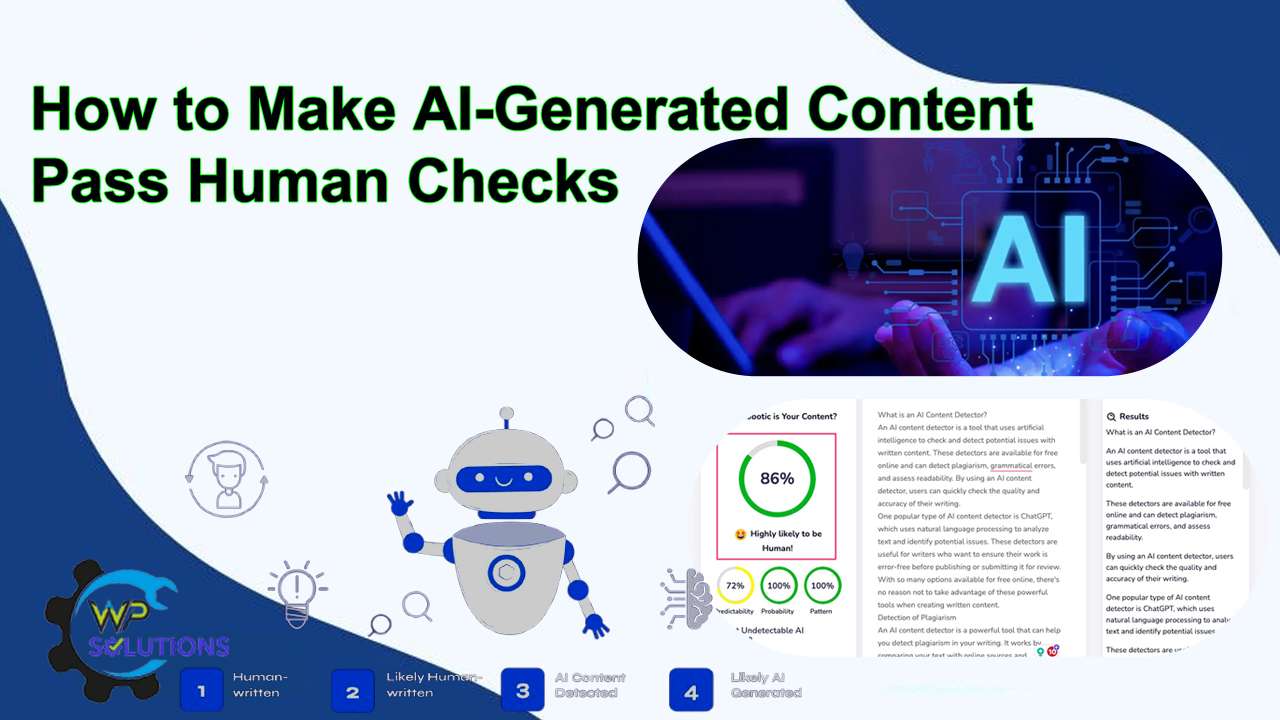AI generated content is everywhere today. Many writers students marketers and business owners use tools like ChatGPT to create blog posts essays social media captions and more. But while AI can help save time people can usually tell if something was written by a robot—and that is a problem when you want your content to feel real and personal.
Human checks are tests or reviews that try to figure out if content was made by a machine or a person. This includes software detectors but also real people checking for style, tone, and originality. If your AI content does not feel natural, it may fail these checks. The good news is that with the right steps, you can make AI content sound more human and pass these reviews easily.
Table of Contents
Use a Clear and Natural Writing Style
AI tools often create content that sounds too perfect or robotic. It may use fancy words, long sentences, or unusual phrases that people do not usually say in everyday life. To fix this, you need to rewrite or adjust the content so it feels more natural. Use short sentences, simple words, and a tone that matches how real people speak.
For example, instead of saying Moreover, individuals must endeavor to maintain productivity A human would say Also, people should try to stay productive. See the difference? A human voice is clear, casual, and warm. Try reading your text out loud—if it sounds weird, it probably needs editing.
Add Personal Opinions, Feelings,s, and Real Experience
AI tools do not have feelings or real life experiences. That is a big giveaway. One of the best ways to humanize AI content is by adding your own thoughts memories or opinions. Say what you think or feel about the topic. Use phrases like In my opinion I have noticed that… or One time I tried.
These small touches make a big difference. They help your reader connect with you and trust your message. If you are writing about travel, for example, mention a place you have been to or a food you loved. AI cannot fake these kinds of details, but you can add them easily.
Avoid Overusing Complex Words and Repeating Phrases
Sometimes AI repeats the same idea with different words or uses big words when smaller ones work better. This makes the text sound strange and boring. For example, AI might say utilize when use is better or commence instead of start. These words sound forced in normal writing.
To fix this, read through your content and replace big or awkward words with simple ones. Also, check for repeated ideas or phrases. If you see something repeated, either remove it or reword it to keep the text fresh and smoothUse.
Human-Like Formatting and Add Lists or Questions
Real writers do not just write in long blocks of text. They use headings bullet points short paragraphs and questions to break up content and make it easy to read. AI sometimes forgets this and creates big chunks of text without structure. That is another red flag.
To pass human checks, use formatting like
- Headings for different topics
- Bullet points or numbered lists
- Questions that make the reader think
- Short paragraphs (2–3 sentences)
These changes make your writing more natural and help readers stay interested.
Paraphrase and Rewrite Parts That Sound Too Robotic
- Even if your AI-generated content is mostly good, some parts might still sound too stiff or fake. When you find those parts, try rewriting them in your own words. Change the sentence structure, reuse different words, or make it more casual.
Here are a few things to look out for
- Too many passive sentences
- Formal or unnatural word choices
- Sentences that do not flow well
Rewriting helps hide the AI fingerprints and makes the content truly your own.
Add Small Errors or Imperfections (But Not Too Many)
This might sound strange, but sometimes making the content a little less perfect helps it feel more human. People make small grammar mistakes, change their tone, or say things in a nonformal way. AI usually avoids these and aims to be perfect, which is a clue for human checkers.
You can use contractions (like do not instead of do not), throw in some casual language ( kind of a I ), or even start a sentence with And or But. Do not overdo it, though—too many errors can make your writing look careless.
Run the Content Through AI Detection Tools and Fix What Fails
There are free and paid tools that check if your content was made by AI. Before you publish or submit anything, run it through these tools. Some of the popular ones include GPTZero, Copyleak,s, and Winston AI. These tools look at sentence patterns, predictability, and structure to guess if a machine wrote it.
If your score is high (meaning it looks like AI wrote it), go back and revise. Focus on the parts the tool flagged and rewrite them with a more personal or conversational tone. Keep testing until the score drops and you feel confident in the final result.
Use Real Research Facts and Sources
AI sometimes makes up facts dates or statistics. This can hurt your content is quality and make it easy to spot as AI generated. To pass human checks always add real trusted information to your content. Look up facts from reliable sources and link to them if needed.
Adding real research also shows that you care about accuracy. Mention the names of people, le pla,ce,s or events. Use numbers, quotes, and data. These are things that AI may miss or get wrong, but you can add them to improve trust and make your work stand out.
Final Touch
The last step is the most important—read your content like a reader,r not a writer. Step away for a few minutes, then come back and read it from start to finish. Ask yourself Does this sound like me? Would I say this out loud? If not, change it.
You can also ask a friend or use a text-to-speech tool to hear how it sounds. Listening helps catch awkward phrases, long sentences,s, or robotic tones. The goal is for someone to read your work and never guess that AI helped write it. Once it feels natural and engaging, you are good to go!
FAQs
Yes with careful editing AI generated content can sound very human. However AI often lacks personal experiences emotions and natural imperfections. By rewriting certain parts adding personal touches and making the tone conversational you can make the content pass both AI detectors and human reviews.
There are several tools available to test for AI generated writing such as
- GPTZero
- Originality.ai
- Copyleaks AI Detector
- Winston AI
These tools analyze sentence structure vocabulary and writing patterns to estimate whether the content was written by a human or an AI.
It depends on how you use it. Using AI as a writing assistant—to generate ideas outline content or fix grammar—is widely accepted. But passing off fully AI written work as your own especially without editing or adding original value can be dishonest especially in academic or professional settings.
It depends on the topic and the AI output. Some content only needs minor edits like adjusting tone and fixing awkward phrases. Other times full paragraphs may need to be rewritten to include personal opinions real experiences or better formatting. A good rule is to always read revise and personalize the content before publishing or submitting it.
Here are some common signs
- Repetitive phrases or ideas
- Overuse of formal or complex words
- Lack of personal opinions or emotions
- Very balanced or neutral tone with no real point of view
- Robotic sentence flow or strange grammar
If you spot these it is likely the content needs human editing to pass as natural.

